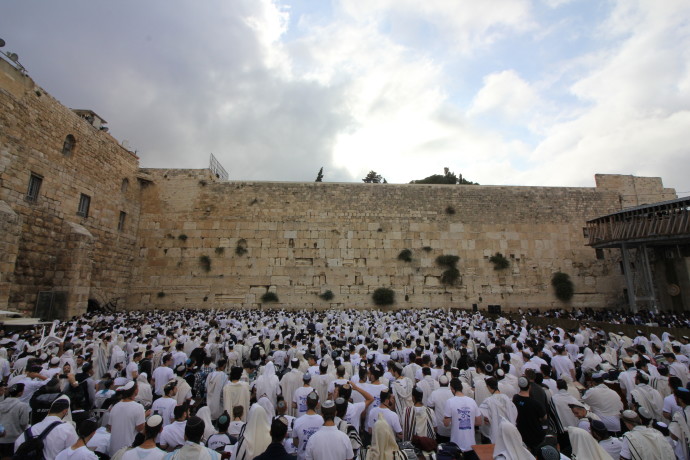Maintaining the Western Wall

Behind the maintenance of the Western Wall is a team of workers on duty twenty-four hours a day, seven days a week, who maintain the physical aspects of the Plaza.
Which historic holy site has space for 16,000 people, possesses 153 Torah scrolls, builds a Sukkah for 400 people, and hosts 10 million people annually? Answer: The Western Wall Plaza, the world’s largest synagogue. The numbers are impressive, but the team of dedicated workers who keep the Western Wall running smoothly is just as remarkable.
For the average visitor, the Western Wall is stirring, inspirational and historic. Behind its spiritual significance is a team of workers on duty twenty-four hours a day, seven days a week, who maintain the physical aspects of the Plaza – from routine activities such as returning prayer books to their shelves, cleaning, and managing all of the tourist attractions at the Wall, to providing security emergency services when needed.
The 150-strong staff at the Western Wall prepares the area for holidays and special events, such as IDF swearing-in ceremonies, maintains relations with the police, municipality, Magen David Adom, and all municipal services, and a myriad of other essential activities.
The nerve center of this activity is at the Western Wall Heritage Center building adjacent to the Kotel, where Eden Shimon presides over the operations division. Shimon has been working for the organization for 16 years and has headed the division for the past four years.
Hanging on the Wall near his desk is a large, framed photo of the Western Wall Plaza taken on a September evening in 2017 during the Selihot prayers before Rosh Hashanah. In the photo, thousands of people fill the square. “When you look at this picture, you simply see a photo with people praying,” says Shimon. “We see a different picture altogether, like MADA (Magen David Adom) areas for dealing with emergencies and cleaning the square after the people have left.”
The operations team at the Western Wall Plaza operates efficiently and quietly. Three shifts of between 40 and 50 workers arrive for each shift, with the first shift beginning at 7 am, the second at 3 pm, and the last from 11 pm until 7 am.
“We divide the area into three separate areas,” explains Shimon, “with the men’s section, the women’s section, and the upper area of the plaza. Each area has its own specific requirements. In addition, the crowds that come to the Kotel on Mondays and Thursdays for Bar Mitzvahs are different than the individual worshippers near the Wall, and their needs are different.”
The Western Wall attracts millions of visitors from different backgrounds, religions, and countries. Haredi men and women in distinctive dress, members of the national religious community, IDF soldiers, secular Jews, and non-Jewish visitors from around the world – all pass through the Kotel Plaza daily.
Shimon points out that the operations team treats everyone – regardless of their religious affiliation – with courtesy and respect. “We don’t differentiate between people,” he says. “We offer the same services to everyone; we maintain the cleanliness of the Kotel for everyone. Everyone should feel at home.” Quoting the famous verse from Isaiah, he says, “For My House shall be called a house of prayer for all peoples.”
The Western Wall Plaza truly becomes a house of prayer during the Jewish holidays. The busiest times at the Kotel are before Rosh Hashanah, the Intermediate Days (Hol HaMoed) of Passover and Sukkot, Jerusalem Day, Tisha B’av, Memorial Day, and Mondays and Thursdays, when Bar Mitzvahs are celebrated. In addition to these peak periods, the Kotel is also used for swearing-in ceremonies for military units throughout the year.
The staff that maintains the Kotel is especially busy at these busy times. Before Sukkot, twenty workers erect a giant Sukkah at the back of the Kotel Plaza that can accommodate 400 people. During the holiday, more ushers are needed, as well as tables where the Torah scrolls are placed, chairs, prayer books, arks (Aronei HaKodesh) for the scrolls, and kippot (skullcaps).
On the Intermediate Days of Passover and Sukkot (Hol HaMoed), the massive Priestly Blessing (Birkat Kohanim) service is held at the Wall, and the plaza fills with tens of thousands of people. The Kotel operations staff prepares special security arrangements for the event, adds extra ushers, prepares special carpets for the Kohanim to place their feet during the blessing, and adds a speaker system so everyone can hear the blessings.
The Kotel operations team is well-trained in preparing for emergencies and security procedures. “We conduct security exercises before all holidays, in case of evacuation or fires,” says Shimon, who adds that regular training is held each month.
Unlike other sites in Israel, the Kotel is a place of prayer, and is open every day of the year, at every time of the day or night. “If you arrive at the Wall at 2 am,” says Shimon, "you will see people getting ready for the morning prayers at sunrise.” Saturday nights are always crowded, he adds, and summer evenings attract large crowds when temperatures are cooler.
As one of the main symbols of Jewish life in Israel, the Western Wall attracts heads of state and leaders from around the world, both Jewish and non-Jewish. Special security arrangements are made when that happens, but even then, Shimon emphasizes that the Wall is always open for prayer to everyone, even if full access is temporarily restricted. When then-US President Donald Trump visited the area in January 2017, for example, the area of Wilson’s Arch remained open for prayers.
Shimon notes that the operations team is always looking to improve the quality of the services it provides visitors to the Wall. Before each holiday season, the staff meets to determine objectives and goals, and after each special event and holiday season, a review is conducted. “After the Tishrei holidays – Rosh Hashanah, Yom Kippur and Sukkot – we meet and discuss what can be improved next year. When we meet the following year before the holidays, we look over the suggestions that were made the previous year and implement the changes that had been suggested.”
This past summer, the operations staff introduced air-conditioned sections in the women’s section of the Wall. He adds that the partitions on the women’s section have small stools that women can stand upon to view Bar Mitzvah celebrations. The women’s gallery in the indoor Wilson’s Arch allows women to hear the Bar Mitzvah celebrant while wearing earphones via Bluetooth.
As our meeting comes to a close, Shimon keeps a close eye on the multiple cameras providing different views of the Kotel at his desk. The work is difficult, but as he says, “God helps. We are not alone.”
The Western Wall is also known as the Wailing Wall or the Kotel



